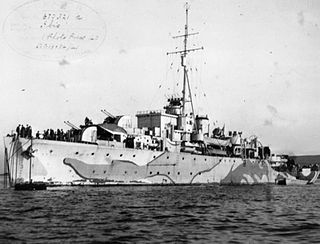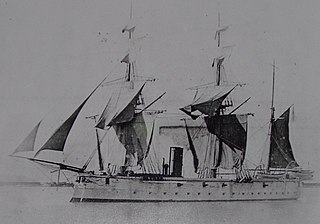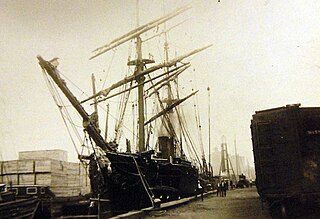
During the 18th and 19th centuries, a sloop-of-war was a warship of the British Royal Navy with a single gun deck that carried up to 18 guns. The rating system of the Royal Navy covered all vessels with 20 or more guns; thus, the term encompassed all unrated warships, including gun-brigs and cutters. In technical terms, even the more specialised bomb vessels and fire ships were classed by the Royal Navy as sloops-of-war, and in practice these were employed in the role of a sloop-of-war when not carrying out their specialised functions.

HMS Ibis, pennant number U99, was a Black Swan-class sloop of the Royal Navy, named after the Ibis.

A screw sloop is a propeller-driven sloop-of-war. They were popularized in the mid-19th century, during the introduction of the steam engine and the transition of fleets to this new technology.

The Black Swan class and Modified Black Swan class were two classes of sloop of the Royal Navy and Royal Indian Navy. Twelve Black Swans were launched between 1939 and 1943, including four for the Royal Indian Navy; twenty-five Modified Black Swans were launched between 1942 and 1945, including two for the Royal Indian Navy; several other ships were cancelled.

The Grimsby class were a class of 13 sloops laid down between 1933 and 1940. Of these, eight were built in the United Kingdom for the Royal Navy, four in Australia for the Royal Australian Navy and one for the Royal Indian Navy. Main armament was initially two 4.7-inch (120 mm) guns for RN ships and three 4-inch (100 mm) for Australian ships, but armament varied considerably between ships, and was increased later.

HMAS Parramatta (U44) was a Grimsby-class sloop of the Royal Australian Navy (RAN). Built during the late 1930s, Parramatta operated in the Red Sea and Mediterranean during World War II. The sloop was torpedoed by the German submarine U-559 on 27 November 1941, and sank with 138 of the 162 aboard.

HMS Whimbrel is the last surviving Royal Navy warship to have been present at the Surrender of Japan in World War II. She was a sloop of the Black Swan-class, laid down on 31 October 1941 to the pennant number of U29 at the famed yards of Yarrow Shipbuilders, Scotstoun, Glasgow.
Sixteen ships of the Royal Navy have been named HMS Pelican, after the bird, while another was planned:

HMS Eaglet is a Royal Navy Reserve unit based in Liverpool. She is the main occupant of the Royal Navy Regional Headquarters in Liverpool, Merseyside. The base is also the home to a number of units, including: Royal Marines Reserve Merseyside, Naval Regional Command Northern England, Liverpool URNU, HMS Biter, HMS Charger, Sea Cadet Corps, and the Liverpool Royal Navy and Royal Marines Careers Office.

The Cruizer class was an 18-gun class of brig-sloops of the Royal Navy. Brig-sloops were the same as ship-sloops except for their rigging. A ship-sloop was rigged with three masts whereas a brig-sloop was rigged as a brig with only a fore mast and a main mast.

The Hastings class, also known as the Folkestone class, was a class of sloop which were built for the Royal Navy and the Royal Indian Navy in the interwar period. In total five ships were built, and went on to see service in the Second World War.

The Amazon class was a class of six screw sloops of wooden construction built for the Royal Navy between 1865 and 1866.

The Bittern-class sloop was a three-ship class of long-range escort vessels used in the Second World War by the Royal Navy.

The Egret-class sloops were a three ship class of a long-range escort vessels used in the Second World War by the Royal Navy. They were an enlarged version of the Bittern class with an extra twin 4-inch gun mounting. They were fitted with Denny Brown stabilisers and the Fuze Keeping Clock anti-aircraft fire control system.

HMS Foxglove was an Acacia-class minesweeping sloop of the Royal Navy. She saw service in World War I and World War II.

HMIS Godavari was a Black Swan-class sloop which served in the Royal Indian Navy (RIN) during World War II.

HMS Pelican was an Osprey-class sloop built for the Royal Navy in the mid-1870s. She was launched in 1877 and was sold to the Hudson's Bay Company in 1901. She was scuttled in 1953.

HMS Stonecrop was a Flower-class corvette of the Royal Navy. She served during the Second World War. She was named after the stonecrop flower (Sedum).
The Snake-class ship-sloops were a class of four Royal Navy sloops-of-war built in the late 18th and early 19th centuries. Though ships of the class were designed with the hull of a brig, their defining feature of a ship-rig changed their classification to that of a ship-sloop rather than that of a brig-sloop.

HMS Chanticleer was a modified Black Swan-class sloop of the Royal Navy. She was laid down by William Denny and Brothers, Dumbarton on 6 June 1941, launched on 24 September 1942 and commissioned on 29 March 1943, with the pennant number U05.


















